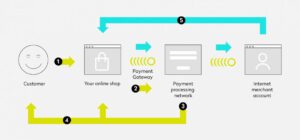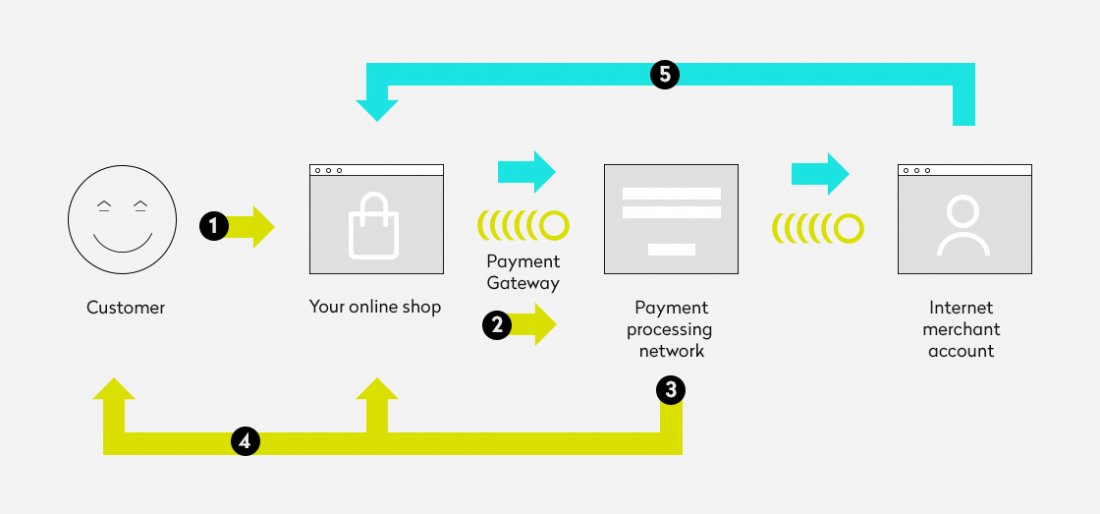we will cover several payment gateways, look at their distinctive features, explain transaction types, and guide you on how to integrate a payment gateway into a website.
It will be a long one, so make yourself a cup of something hot and tasty – and read on.
What is a payment gateway
Before you learn how to add a payment gateway to a website in great detail, it’s important to understand what it actually is.
A payment gateway processes credit cards at online and offline stores. It transfers the key information between websites/mobile devices and payment processors/banks, and vice versa.
So if you decide to integrate payment into a website and make the user experience smooth, think of the gateway as a tool to deal with all the financial transactions online.
Basically, it’s an online representation of a real point of sale terminal that you see in retail stores. To ensure the transaction safety and protect your website from fraud, a payment gateway encrypts all sensitive information: credit card number, expiration date, and CVV code.
How does a payment gateway work
The main task of a payment gateway is to process credit card information of online customers dropping to your e-commerce store for example.
See our step-by-step tutorial to get familiar with the process A to Z.

1. The customer presses the “Place order button at checkout. The browser encrypts the payment details and sends them to the merchant’s web server via SSL connection.
2. The merchant sends these details to a gateway – again via an encrypted SSL connection.
3. The payment gateway sends the information to the payment processor, which, in turn, forwards it to the card association (Visa, MasterCard, etc.).
4. The bank that issues the credit card receives an authorisation request and sends a response code back to the payment processor. The response code contains information about the transaction status (approved or failed) and the error code in case the transaction failed (insufficient funds, etc.).
5. The payment processor sends the response code on to the gateway, and from there it’s forwarded back to the website.
6. The website displays a relevant message to the customer.
The whole process takes as little as 2-3 seconds!
The payment gateway for a website: transaction types
Before jumping into the details of payment gateway integration, let’s see what types of payment transactions exist – depending on your business, you may want to pick a specific one for your e-commerce site or a portal.
The common transaction types are authorisation, capture, sale, refund, and void.
Authorisation
This type is used to determine the customer’s ability to pay and find out if there are enough funds on their credit card. The actual fund transfer doesn’t take place in this case.
It makes sense to use the authorisation transaction type if it takes some time for you to ship the products ordered online and you need to guarantee the funding by the card issuer.
Capture
Capture transaction lets you capture the money that was previously authorised and send it for settlement. Thus, if you sold a product online that took time to manufacture/prepare for shipping, you first need to authorize the payment, and when the product has been shipped – capture the amount, and it will be transferred to your account.
Sale
Sale transaction combines authorisation and capture. If you fulfil orders immediately that’s the transaction type you should use – the money is charged and transferred at once. It will also be suitable if you sell a service membership and immediately provide the user with access.
Refund
Things happen, and if an order has to be cancelled for some reason, the merchant will need to refund a transaction and submit it for processing. Most of the time, a refund is limited to the original amount authorized and can only be applied to Sale and Capture transactions.
Void
A void transaction is similar to a refund, but it can only be applied if the transaction hasn’t been settled (captured) yet. Typically, the transaction will disappear from the customer’s account statement within 24 hours, while it may take 3 to 5 business days to process a refund. Voids are also a bit cheaper than refunds.

